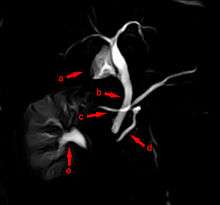Pancreas divisum
Pancreas or Pancreatic divisum is a congenital anomaly in the anatomy of the ducts of the pancreas in which a single pancreatic duct is not formed, but rather remains as two distinct dorsal and ventral ducts.
| Pancreas divisum | |
|---|---|
| Specialty | Medical genetics |
Symptoms
A majority of individuals born with pancreas divisum will not have symptoms. In some cases, pancreas divisum is only detected during autopsy.[1] A small group of individuals will develop symptoms which commonly include abdominal pain, nausea, vomiting, and acute and chronic pancreatitis.[2]
Causes
The human embryo begins life with two ducts in the pancreas, the ventral duct and the dorsal duct. Normally, the two ducts will fuse together to form one main pancreatic duct; this occurs in more than 90% of embryos. In approximately 10% of embryos the ventral and dorsal ducts fail to fuse together, resulting in pancreas divisum. In utero, the majority of the pancreas is drained by the dorsal duct which opens up into the minor duodenal papilla. The ventral duct drains the minority of the pancreas and opens into the major duodenal papilla. In adults however, this situation is reversed whereby 70% of the pancreas is drained by the ventral duct. Therefore in pancreas divisum, where fusion of the ducts does not occur, the major drainage of the pancreas is done by the dorsal duct which opens up into the minor papilla.
Diagnosis

The most common and accurate way of diagnosing an individual with this anomaly is by MRCP (Magnetic Resonance Cholangiopancreatography) or ERCP (Endoscopic Retrograde Cholangiopancreatography). This test can demonstrate the presence of two separately draining ducts within the pancreas. Other tests can assist doctors with diagnosis, such as a CT scan and an MRI.
Treatment
Pancreas divisum in individuals with no symptoms does not require treatment. Treatment of those with symptoms varies and has not been well established. A surgeon may attempt a sphincterotomy by cutting the minor papilla to enlarge the opening and allow pancreatic enzymes to flow normally. During surgery, a stent may be inserted into the duct to ensure that the duct will not close causing a blockage. This surgery can cause pancreatitis in patients, or in rare cases, kidney failure and death.
An association with adenoma of the minor papilla has been reported.[3]
References
- Pancreatic Divisum at eMedicine
- "Archived copy". Archived from the original on 2013-04-25. Retrieved 2013-04-24.CS1 maint: archived copy as title (link)
- Nakamura Y, Tajiri T, Uchida E, et al. (2007). "Adenoma of the minor papilla associated with pancreas divisum". Hepatogastroenterology. 54 (78): 1841–3. PMID 18019730.
External links
| Classification | |
|---|---|
| External resources |